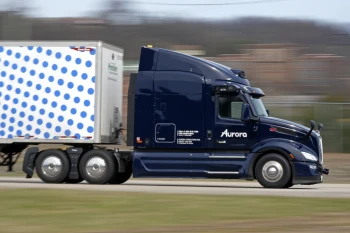The advent of self-driving trucks marks a significant technological leap in the realm of transportation and logistics. As the world witnesses the dawn of autonomous vehicles, particularly in the freight industry, the implications and potential benefits are vast and transformative.
The narrative of a driverless semi-truck navigating through traffic with precision and efficiency may seem like a scene from a sci-fi movie, but it is rapidly becoming a reality on the bustling highways of America.
Pittsburgh, a city known for its innovation and technological advancements, stands at the forefront of this transportation revolution.
Aurora Innovation, a Pittsburgh-based company, is leading the charge by introducing self-driving trucks equipped with an array of sensors and cutting-edge technology. These trucks are poised to revolutionize the way goods are transported, promising faster delivery times, increased efficiency, and potentially reduced costs.
The prospect of fleets of autonomous trucks crisscrossing the country’s freeways is not a distant dream but a near-term reality.
Within the next three to four years, Aurora and its competitors envision deploying thousands of self-driving trucks on public roads, transforming the landscape of the transportation industry.
These trucks, capable of operating almost continuously without the need for breaks, hold the promise of streamlining logistics operations and enhancing the overall flow of goods.
One of the key advantages touted by companies investing in autonomous trucking is the potential for significant fuel savings.
By eliminating the need for frequent stops and maintaining consistent speeds, these driverless trucks are expected to operate more efficiently, leading to reduced fuel consumption and lower carbon emissions.
Moreover, advancements in technology have enabled these vehicles to address maintenance issues autonomously, ensuring seamless operations and minimal disruptions on the road.
While the concept of massive driverless trucks sharing the road with traditional vehicles may evoke apprehension among the general public, it is crucial to recognize the extensive testing and safety measures undertaken by companies like Aurora to ensure the reliability and security of autonomous transportation.

Despite initial skepticism and concerns, the gradual integration of self-driving trucks into the freight industry represents a significant step towards a more efficient and sustainable future.
As Aurora prepares to launch its driverless trucks on freight routes in Texas, the potential benefits of autonomous transportation are poised to be realized on a larger scale.
Collaborations with industry giants like FedEx, Uber Freight, and Werner signify a shift towards embracing innovation and technology to enhance the efficiency and reliability of logistics operations.
With Texas serving as a testing ground for autonomous freight transportation, the stage is set for a new era in the evolution of the transportation industry.
In conclusion, the emergence of self-driving trucks heralds a new chapter in the evolution of transportation and logistics.
The convergence of advanced technology, innovative solutions, and strategic partnerships is paving the way for a future where autonomous vehicles play a central role in shaping the efficiency and sustainability of freight transportation.
As the journey towards fully autonomous transportation accelerates, the promise of faster delivery times, reduced costs, and enhanced operational efficiency looms on the horizon, ushering in a new era of transportation innovation.
In the realm of autonomous vehicles, the trajectory of progress has taken an unexpected turn. While initial expectations centered around the proliferation of self-driving cars for ride-hailing services in bustling urban centers, recent developments suggest a different narrative unfolding.
General Motors’ Cruise robotaxi unit finds itself grappling with the repercussions of a significant crash, while Alphabet’s Waymo encounters resistance to expanding its autonomous ride service in California.
These challenges have paved the way for self-driving trucks to emerge as the frontrunners in the deployment of computer-controlled vehicles on public roads at a large scale.
Amidst this transition, safety advocates have voiced concerns regarding the lack of substantial federal regulation governing the operation of autonomous trucks.
The onus largely falls on the companies themselves to determine the readiness of these vehicles to operate without human intervention.
Critics argue that federal agencies, such as the National Highway Traffic Safety Administration, have adopted a predominantly reactive stance towards safety, often springing into action only post-accidents. Furthermore, the regulatory landscape across most states remains inadequately defined.
In contrast, companies like Aurora, along with other industry players, assert that extensive testing has demonstrated the potential for self-driving trucks to outperform their human-driven counterparts in terms of safety.
Leveraging advanced sensor technologies such as laser and radar systems, these vehicles possess the ability to perceive their surroundings with a level of precision exceeding human capabilities.
They operate tirelessly, devoid of fatigue, distractions, or impairment from substances like alcohol or drugs.
Chris Urmson, CEO of Aurora and former head of Google’s autonomous vehicle division, emphasizes the paramount importance of ensuring safety as a prerequisite for widespread acceptance of autonomous trucks by the public and industry stakeholders alike.
The vision of deploying thousands or even tens of thousands of trucks on the roads hinges on establishing robust safety protocols. Urmson underscores that safety serves as the linchpin for garnering trust from both the public and customers.
However, Phil Koopman, a vehicle automation safety expert from Carnegie Mellon University, cautions that despite the potential safety advantages of self-driving trucks over human drivers, the inevitability of errors in the vehicles’ computer systems poses a critical challenge.
The efficacy of these trucks in real-world scenarios, he asserts, will be contingent upon the efficacy of their safety engineering practices. As the industry grapples with substantial investments, Koopman raises concerns about the delicate balance between safety considerations and cost efficiency.
The testing phase offers glimpses of promise, with reports showcasing Aurora’s semis adeptly navigating simulated road obstacles, including pedestrians and unexpected hazards like a blown tire or even a horse.
These tests, conducted at controlled speeds, underscore the vehicles’ ability to swiftly react to potential dangers. Aurora’s trucks have logged over a million miles autonomously on public highways since 2021, with human safety drivers onboard.
Notably, the few minor crashes that occurred were attributed to errors by human drivers in other vehicles, with the Aurora trucks safely maneuvering to the roadside.
Despite the overall positive track record, a federal database highlights several instances of crashes involving autonomous semis colliding with other vehicles, including a few involving Aurora trucks.
In these cases, the accidents were primarily caused by erratic behavior from other vehicles or abrupt lane changes, prompting human safety drivers to intervene in some instances.
Urmson reaffirms Aurora’s unwavering commitment to prioritizing safety, even if it means potentially delaying profitability milestones.

In the quest for operationalizing self-driving trucks on a large scale, the industry faces a pivotal juncture where safety considerations must reign supreme.
The narrative of autonomous vehicle deployment has shifted towards the realm of freight transportation, with self-driving trucks poised to revolutionize the logistics landscape.
As the industry navigates the intricate interplay between technological innovation, regulatory oversight, and safety imperatives, the journey towards a future dominated by autonomous trucks unfolds with both promise and challenges.
The evolution of self-driving trucks symbolizes a paradigm shift in the realm of transportation, heralding a new era where human ingenuity converges with cutting-edge technology to redefine the contours of mobility on public roads.
